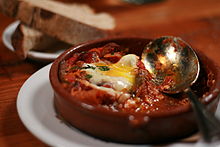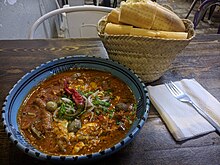| Revision as of 00:21, 19 April 2024 editLEvalyn (talk | contribs)Autopatrolled, Extended confirmed users, New page reviewers5,470 edits no need to undo the whole restructure over one word -- Undid revision 1219627318 by M.Bitton (talk)Tag: Undo← Previous edit | Revision as of 00:22, 19 April 2024 edit undoLEvalyn (talk | contribs)Autopatrolled, Extended confirmed users, New page reviewers5,470 edits adding cite for speculative Egyptian originTag: Visual editNext edit → | ||
| Line 28: | Line 28: | ||
| ==History== | ==History== | ||
| The origin of the dish remains a matter of some controversy with competing claims of Egyptian,{{ |
The origin of the dish remains a matter of some controversy with competing claims of Egyptian,<ref>{{Cite news |last=Naylor |first=Tony |date=2021-04-03 |title=How to eat: shakshuka |url=https://www.theguardian.com/food/2021/apr/03/how-to-eat-shakshuka |access-date=2024-04-19 |work=The Guardian |language=en-GB |issn=0261-3077}}</ref> Libyan, Moroccan, Tunisian, Turkish, and Yemeni origins.<ref name="thejc">{{cite news |url=https://www.thejc.com/lifestyle/food/shakshuka-israel-s-hottest-breakfast-dish-1.11723 |title=Shakshuka: Israel's hottest breakfast dish |last=Josephs |first=Bernard |date=2009-10-08 |work=] |access-date=2017-08-07 |archive-url=https://web.archive.org/web/20170808035018/https://www.thejc.com/lifestyle/food/shakshuka-israel-s-hottest-breakfast-dish-1.11723 |archive-date=2017-08-08 |url-status=live }}</ref><ref>{{cite book |title=Global Jewish Foodways: A History |publisher=University of Nebraska Press |date=2018 |url=https://books.google.com/books?id=B-dVDwAAQBAJ&pg=PA104 |page=104|isbn=9781496202284 }}</ref><ref>{{Cite news |last=Naylor |first=Tony |date=2021-04-03 |title=How to eat: shakshuka |url=https://www.theguardian.com/food/2021/apr/03/how-to-eat-shakshuka |access-date=2024-04-18 |work=The Guardian |language=en-GB |issn=0261-3077}}</ref> According to ], shakshouka originated in ] ] in the mid-16th century after tomatoes were introduced to the region by ] as part of the ].<ref>{{cite book |last=Nathan |first=Joan |url=https://books.google.com/books?id=bfGmDAAAQBAJ&pg=PA16 |title=A Culinary Exploration of Jewish Cooking from Around the World: A Cookbook |date=2017 |publisher=Knopf Doubleday Publishing |isbn=9780385351157 |page=16 |quote=Shakshuka was born in Ottoman North Africa in the mid-sixteenth century}}</ref> | ||
| ] immigrants brought the dish to Israel in the 1950s and 1960s, though it only became popular on menus in the 1990s.<ref name="Irish"/><ref name="marks">Gil Marks, ''Encyclopedia of Jewish Food'', Houghton Mifflin Harcourt, 2010, {{isbn|9780470391303}}, ''s.v.'', p. 547</ref> A shakshouka made with a ] version of ]<!--capitalised as a trade name--> (called '']'') was added to ] army rations in the 1950s.<ref>{{cite news |last1=Steinberg |first1=Jessica |date=20 November 2012 |title=The rationale behind the rations |url=https://www.timesofisrael.com/the-rationale-behind-the-rations/ |work=The Times of Israel}}</ref><ref>{{Cite book |last=Raviv |first=Yael |url=https://books.google.com/books?id=dWZ5CgAAQBAJ |title=Falafel Nation: Cuisine and the Making of National Identity in Israel |date=November 2015 |publisher=University of Nebraska Press |isbn=978-0-8032-9023-5 |page=171}}</ref> | ] immigrants brought the dish to Israel in the 1950s and 1960s, though it only became popular on menus in the 1990s.<ref name="Irish"/><ref name="marks">Gil Marks, ''Encyclopedia of Jewish Food'', Houghton Mifflin Harcourt, 2010, {{isbn|9780470391303}}, ''s.v.'', p. 547</ref> A shakshouka made with a ] version of ]<!--capitalised as a trade name--> (called '']'') was added to ] army rations in the 1950s.<ref>{{cite news |last1=Steinberg |first1=Jessica |date=20 November 2012 |title=The rationale behind the rations |url=https://www.timesofisrael.com/the-rationale-behind-the-rations/ |work=The Times of Israel}}</ref><ref>{{Cite book |last=Raviv |first=Yael |url=https://books.google.com/books?id=dWZ5CgAAQBAJ |title=Falafel Nation: Cuisine and the Making of National Identity in Israel |date=November 2015 |publisher=University of Nebraska Press |isbn=978-0-8032-9023-5 |page=171}}</ref> | ||
Revision as of 00:22, 19 April 2024
Maghrebi dish of eggs poached in a sauce For the shredded flatbread and chickpea dish, see Chakhchoukha. For the Turkish eggplant dish, see Şakşuka. For the documentary film, see The Shakshuka System. Shakshouka in a cast iron pan Shakshouka in a cast iron pan | |
| Alternative names | Shakshuka, chakchouka |
|---|---|
| Type | Main dish |
| Place of origin | Ottoman North Africa |
| Main ingredients | Tomatoes, harissa, eggs, olive oil |

Shakshouka (Template:Lang-ar : šakšūkah, also spelled shakshuka or chakchouka) is a dish of eggs poached in a sauce of tomatoes, olive oil, peppers, onion, and garlic, commonly spiced with cumin, paprika and cayenne pepper. The exact origins of the dish are disputed, but it developed in North Africa some time after the introduction of tomatoes to the region through the the Columbian exchange. A wide range of regional variations involve different ingredients for the base sauce or different accompaniments.
Etymology
The word shakshouka (Template:Lang-ar) is a Maghrebi Arabic term for "a mixture". According to Mary Fitzgerald, the word is allegedly believed to come from the Berber languages, although most sources agree on the term's Arabic origin. In Morocco, it is referred to as bīḍ w-maṭiša (بيض ومطيشة "egg and tomato"). The term shakshouka may have derived from "shak", another Arabic word meaning "to combine things together", as the dish combines tomatoes, chilies and eggs.
History
The origin of the dish remains a matter of some controversy with competing claims of Egyptian, Libyan, Moroccan, Tunisian, Turkish, and Yemeni origins. According to Joan Nathan, shakshouka originated in Ottoman North Africa in the mid-16th century after tomatoes were introduced to the region by Hernán Cortés as part of the Columbian exchange.
North African Jewish immigrants brought the dish to Israel in the 1950s and 1960s, though it only became popular on menus in the 1990s. A shakshouka made with a kosher version of Spam (called loof) was added to Israel Defense Forces army rations in the 1950s.
Variations


Shakshouka is a popular dish throughout the Middle East and North Africa. Because eggs are the main ingredient, it often appears on breakfast menus in English-speaking countries, but in the Arab world as well as Israel, it is also a popular evening meal, and like hummus and falafel, is a Levantine regional favorite. On the side, pickled vegetables and North African sausage called merguez might be served, or simply bread, with mint tea.
Many variations of the basic sauce are possible, varying in spice and sweetness. Some cooks add preserved lemon, salty sheep milk cheeses, olives, harissa or a spicy sausage such as chorizo or merguez. Some variations of shakshouka can be made with lamb mince, toasted whole spices, yogurt and fresh herbs. Spices can include ground coriander, caraway, paprika, cumin and cayenne pepper. The North African dish matbukha can be used as a base for shakshouka.
In Algeria, shakshouka is commonly eaten as a side dish, with many variations. One such variation is hmiss, which is often served alongside traditional kesra bread. Hmiss typically includes grilled peppers, tomatoes, and garlic. In Tunisia, a similar dish called slata meshouia is enjoyed, but it differs from hmiss with the addition of onions, cumin and tuna. Tunisian cooks may add potatoes, broad beans, artichoke hearts or courgettes to the dish. In the Turkish menemen, the eggs can be scrambled. In Jewish culture, a large batch of tomato stew is made for the Sabbath dinner and the leftovers used the following morning to make a breakfast shakshouka with eggs. In Andalusian cuisine, the dish is known as huevos a la flamenca; this version includes chorizo and serrano ham. In Italian cuisine, there is a version of this dish called uova in purgatorio (eggs in purgatory) that adds garlic, basil or parsley.
See also
References
- Ellis, Robin (2016-03-03). Mediterranean Cooking for Diabetics: Delicious Dishes to Control or Avoid Diabetes. Little, Brown Book Group. ISBN 9781472136381. Archived from the original on 2017-11-16. Retrieved 2017-11-15.
- Ly, Linda (2015-03-20). The CSA Cookbook: No-Waste Recipes for Cooking Your Way Through a Community Supported Agriculture Box, Farmers' Market, Or Backyard Bounty. Voyageur Press. ISBN 9780760347294. Archived from the original on 2017-11-16. Retrieved 2017-11-15.
- Planet, Lonely (2017-03-01). The World's Best Superfoods. Lonely Planet. ISBN 9781787010369. Archived from the original on 2017-11-16. Retrieved 2017-11-15.
- Bilderback, Leslie (2015-09-01). Mug Meals: More Than 100 No-Fuss Ways to Make a Delicious Microwave Meal in Minutes. St. Martin's Press. ISBN 9781466875210. Archived from the original on 2017-11-16. Retrieved 2017-11-15.
- Jakob, Ben (2017-06-06). "How Shakshuka, Israel's Famous Breakfast Dish, Took the World By Storm". Culture Trip. Archived from the original on 2017-11-16. Retrieved 2017-11-15.
- ^ Fitzgerald, Mary (Apr 24, 2021). "Shakshuka: All mixed up over a brilliant breakfast". The Irish Times. Retrieved 2021-09-09.
- "وداعا "البيض ومطيشة"". Hespress - هسبريس جريدة إلكترونية مغربية (in Arabic). 2012-10-16. Retrieved 2022-01-26.
- ^ Salah, Maha (14 February 2020). "Shakshuka". Middle East Monitor.
- Naylor, Tony (2021-04-03). "How to eat: shakshuka". The Guardian. ISSN 0261-3077. Retrieved 2024-04-19.
- ^ Josephs, Bernard (2009-10-08). "Shakshuka: Israel's hottest breakfast dish". The Jewish Chronicle. Archived from the original on 2017-08-08. Retrieved 2017-08-07.
- Global Jewish Foodways: A History. University of Nebraska Press. 2018. p. 104. ISBN 9781496202284.
- Naylor, Tony (2021-04-03). "How to eat: shakshuka". The Guardian. ISSN 0261-3077. Retrieved 2024-04-18.
- Nathan, Joan (2017). A Culinary Exploration of Jewish Cooking from Around the World: A Cookbook. Knopf Doubleday Publishing. p. 16. ISBN 9780385351157.
Shakshuka was born in Ottoman North Africa in the mid-sixteenth century
- ^ Gil Marks, Encyclopedia of Jewish Food, Houghton Mifflin Harcourt, 2010, ISBN 9780470391303, s.v., p. 547
- Steinberg, Jessica (20 November 2012). "The rationale behind the rations". The Times of Israel.
- Raviv, Yael (November 2015). Falafel Nation: Cuisine and the Making of National Identity in Israel. University of Nebraska Press. p. 171. ISBN 978-0-8032-9023-5.
- Clifford-Smith, Stephanie (2011-06-07). "Three of a kind ... shakshouka". Sydney Morning Herald. Archived from the original on 2017-08-08. Retrieved 2017-08-07.
- Ashkenazi, Michael (2020). Food Cultures of Israel: Recipes, Customs, and Issues. p. 89.
- "Shakshuka recipe". The Guardian. February 18, 2012.
- Gordon, Peter (2018-06-03). "Peter Gordon's lamb shakshouka recipe". The Guardian. ISSN 0261-3077. Retrieved 2018-07-21.
- "Shakshouka Recipe – Tunisian Recipes". PBS Food. 2015-03-12. Retrieved 2018-07-21.
- Clark, Melissa. "Shakshuka With Feta Recipe". NYT Cooking. Retrieved 2018-07-21.
- Gur, Janna (2014). Jewish Soul Food: From Minsk to Marrakesh.
- Roden, Claudia (1996). The Book of Jewish Food: An Odyssey from Samarkand to New York. Knopf. p. 512. ISBN 9780394532585.
- Joel Lurie Grishaver (2008). Artzeinu: An Israel Encounter.
- Tish, Ben (2019). Moorish: Vibrant Recipes from the Mediterranean. Bloomsbury. p. 46. ISBN 9781472958082.
- "Uova in purgatorio". La Cucina italiana (in Italian). 20 August 2015. Retrieved 2023-06-24.
External links
 Quotations related to Shakshouka at Wikiquote
Quotations related to Shakshouka at Wikiquote
| Cuisine of Tunisia | |
|---|---|
| Breads, dishes, and soups | |
| Ingredients | |
| Beverages | |
| Desserts and pastries | |
| Related | |
| Algerian cuisine | |
|---|---|
| Dishes | |
| Soups | |
| Brochettes | |
| Ingredients | |
| Beverages | |
| Desserts and pastries | |
| Related | |
| Jewish cuisine | |||||||||||
|---|---|---|---|---|---|---|---|---|---|---|---|
| History | |||||||||||
| Types | |||||||||||
| Religious dietary laws and related terms | |||||||||||
| Chefs | |||||||||||
| Religious foods | |||||||||||
| Breads |
| ||||||||||
| Sweets |
| ||||||||||
| Pastries | |||||||||||
| Fried foods |
| ||||||||||
| Dumplings, pastas and grain dishes |
| ||||||||||
| Casseroles and savory baked dishes | |||||||||||
| Snacks and other baked goods | |||||||||||
| Sandwiches | |||||||||||
| Egg dishes | |||||||||||
| Meat dishes | |||||||||||
| Fish dishes | |||||||||||
| Salads and pickles | |||||||||||
| Vegetable dishes | |||||||||||
| Soups and stews | |||||||||||
| Cheeses and other dairy products | |||||||||||
| Condiments, dips and sauces | |||||||||||
| Beverages | |||||||||||
| Herbs, spices and seasonings | |||||||||||
| Eateries | |||||||||||
| Related lists | |||||||||||
| Moroccan cuisine | |
|---|---|
| Dishes (list) | |
| Brochettes | |
| Ingredients | |
| Soups | |
| Breads | |
| Desserts & pastries | |
| Beverages | |
| Related cuisines | |
- Arab cuisine
- Libyan cuisine
- Tunisian cuisine
- Algerian cuisine
- Moroccan cuisine
- Israeli cuisine
- Egyptian cuisine
- Yemeni cuisine
- Egg dishes
- National dishes
- Mizrahi Jewish cuisine
- Sephardi Jewish cuisine
- Maghrebi cuisine
- Ottoman cuisine
- Spanish cuisine
- Italian cuisine
- Meze
- Tomato dishes
- Breakfast
- Transatlantic cultural exchange
- Shabbat food
- Middle Eastern cuisine
- Berber cuisine
- Romani cuisine
- Palestinian cuisine